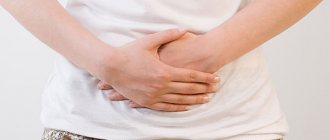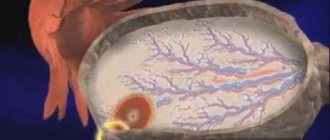Lower abdominal pain in women: causes
The nature of such pain is not always pathological.
If the lower abdomen produces a slightly aching pain and it is short-lived, then the fairer sex has absolutely no reason to fear.
But when the pain becomes more frequent and becomes cramping, sometimes unbearable, this indicates signs of other pathologies.
Pain in the lower abdomen, as during menstruation, has various sources of origin. They come in both organic and functional varieties.
The organic origin of pain includes:
- Inflammation in the ovary;
- Benign tumors in the uterus;
- Neoplasms: cysts;
- Prolonged stay of the IUD in the uterus;
- Pathologies of a surgical nature;
- Disorders of the urinary system;
- Diseases occurring in the gallbladder;
- Pregnancy and ectopic pregnancy;
- Low placenta previa;
- Placental abruption occurs prematurely;
- Abortion and the condition after it.
Pain of functional origin occurs when:
- menstruation disorders;
- dysfunctional bleeding from the uterus;
- during ovulation, the lower abdomen hurts, as during menstruation;
- bend of the uterus.
The pain varies from aching to cramping.
Often the cause of their appearance is a disruption of the hormonal cycle. Pain that occurs after menstruation indicates the presence of endometriosis. In diseases of the gastrointestinal tract, pain radiates to the lower abdomen.
In exceptional cases, pain begins as a response from the female body.
Attention! Experts recommend not taking medications without consulting a doctor, dulling the pain with painkillers! This can be fraught with consequences and threaten the health and even life of the fairer sex!
Pathological causes
If a woman experiences alarming symptoms after ovulation, she should immediately go to the hospital, as many gynecological diseases can lead to dangerous consequences and serious complications. Warning signs include:
- severe pain (possible stabbing and cutting pain);
- bleeding;
- dyspnea;
- dizziness;
- painful bowel movements or urination;
- hypertonicity of the abdominal muscles.
In many pathologies, a woman may experience symptoms of general intoxication: fever, weakness, vomiting and nausea. Pain due to pathologies caused by disturbances in the functioning of the organs of the reproductive and reproductive systems is difficult to relieve with medications and can radiate to the coccyx, shoulder and even the interscapular area.
Video - Pain in the lower abdomen
Urogenital infections
Often, pain after ovulation is not associated with the process of the egg being released from the ovaries. One of the causes of nagging pain can be inflammatory diseases of the genitourinary system, for example, inflammation of the walls of the bladder (cystitis). Cystitis is often infectious in nature and requires antibiotic therapy. If you do not go to the hospital when the first symptoms appear, the disease will become chronic and will worsen periodically with the slightest decrease in immunity.
Cystitis has the following clinical manifestations:
- temperature increase;
- cloudiness of urine and sedimentation;
- pain and cramping during emptying of the bladder;
- burning during urination;
- frequent trips to the toilet.
Kidney pathologies are another cause of pulling sensations in the abdomen. Inflammatory processes can affect the renal pelvis, calyx and parenchyma (pyelonephritis) or glomeruli (glomerulonephritis). The pain syndrome during an acute process has a pronounced intensity and is localized in the lower and lateral parts of the abdomen.
Sexual infections
In some cases, the lower abdomen may feel tight due to the development of sexually transmitted infections. Pain is usually the first clinical sign; other symptoms begin to appear within 2-5 days. The duration of their occurrence depends on the type of pathogen and the incubation period. In addition to pain, a woman may also notice a change in the nature and color of the discharge, the appearance of an unpleasant odor and pain. Characteristics of the main sexually transmitted infections are presented in the table below.
| Group of infections | What diseases are included? | Characteristic |
| Fungal | Candidiasis (thrush) | Discharge from thrush has a white, cream or milky beige hue. The consistency is cheesy interspersed with small white particles. The smell is usually reminiscent of kefir products. Additional symptoms include burning and itching in the perineum and vaginal tract |
| Viral | Genital herpes | With viral infections, the discharge has a mucous consistency and a transparent tint (may be cloudy). The discharge is abundant, rarely has a pungent odor, and resembles thick, coagulated egg whites. Mucus lumps may be present |
| Bacterial | Gonorrhea, chlamydia, bacterial syphilis, etc. | The discharge is thick, yellow, green or brown. They have a sharp putrid odor, reminiscent of rotten fish. Accompanied by severe itching and burning. The skin in the perineal area is irritated, ulcers may appear |
Important! Pain syndrome during sexually transmitted infections usually appears in the first 1-3 days, after which it weakens, and other signs characteristic of this group of diseases appear.
Uterine diseases
Pathologies in the functioning of the uterus are one of the most common causes of prolonged postovulatory syndrome. The following diseases can cause pronounced pulling sensations after the release of a mature egg from the ovary:
- uterine fibroids - a pathology of the myometrium (muscular layer of the organ), characterized by the growth of benign formations;
- endometriosis - proliferation of the mucous membrane of the uterine walls and penetration of endometrial cells into other tissues;
- endometrial hyperplasia - pathological growth of epithelial cells lining the inner surface of the uterus;
- cervical erosion is a defect in the mucous membrane of the cervix that is benign in nature;
- Uterine polyposis is the growth of benign tumors (polyps) on the walls of the uterus.
Important! Any of these diseases can lead to serious consequences if left untreated. Any benign processes can lead to the growth of malignant cells, so such pathologies should be under constant medical supervision. If diseases of the uterus have taken a chronic course, a woman will have a pull in her stomach after ovulation and before menstruation.
Ovarian pathologies
Inflammation of the appendages (fallopian tubes and ovaries) can also be characterized by the occurrence of painful pulling sensations. Nagging pain is also characteristic of cystic formations - growths in the form of a sac filled with clear liquid. If the cyst becomes inflamed and bursts, infection and inflammation of the peritoneal organs (peritonitis), purulent blood poisoning (sepsis) and general intoxication of the body may develop, so any cystic growths must be detected in a timely manner, undergoing a routine examination by a gynecologist at least once a year.
Ovarian cyst rupture statistics
The nagging pain that occurs after ovulation is in most cases a normal symptom of the physiological processes that occur in a woman’s body during this period. Seek medical help and get tested if the pain does not go away 3-5 days after ovulation, causes significant discomfort, or is accompanied by other warning signs. If a nagging pain appears a week after the follicle ruptures, it makes sense to take a pregnancy test, since the possibility of conception cannot be ruled out.
source
Why does my stomach hurt during menstruation?
Menstruation in a woman or girl is characterized by certain signs:
- Constant fatigue;
- Nervousness;
- Irritability;
- Lower abdominal pain.
The duration of these pains is from 3 to 7 days.
Why does pain occur? Pain syndrome is present in functional states during menstruation. But it is also pathological in nature.
It is important to know! These pains, as during menstruation, in the lower abdomen are characteristic of inflammation occurring in the pelvic organs.
In gynecology, there is a name that characterizes the pain felt during menstruation. This physiological condition is called dysmenorrhea.
Dysmenorrhea occurs:
- Primary;
- Secondary.
With primary dysmenorrhea, pain appears before menstruation. They last up to 4 days.
This type of pathology is typical for girls from adolescence to 25 years. These pains are accompanied by various dyspeptic disorders. Over time, the pain subsides after the baby is born.
During secondary dysmenorrhea, pain occurs only as a result of pathological changes in the area of the pelvic organs. This is observed in middle age categories (after 30 years).
The following factors are related to such pathologies:
- use of an intrauterine device;
- inflammation occurring in the pelvis;
- endometriosis.
Sometimes severe pain in the lower abdomen in women is a harbinger of cancer.
The birth of a new life
The first month after conception is the most significant during the entire pregnancy. At this time, the formation of the embryo, the laying of the main organs and the most significant changes in the female body occur.
Every month of pregnancy is important, but only at the very beginning is the foundation laid for the future development and growth of the fetus.
Conception is possible on days 14-16 of the menstrual cycle, when ovulation occurs and a mature egg is released from the ovary.
When the sperm and egg combine during this period, fertilization occurs and pregnancy occurs. Signs that it is time to ovulate:
- weakness,
- fast fatiguability,
- increased libido,
- increased basal temperature.
You can accurately determine the onset of ovulation by measuring the temperature in the anus.
To do this, it is necessary to measure basal temperature every morning, starting from the 13th to the 16th day of the cycle, without getting out of bed.
An increase in its value above 37 degrees indicates ovulation. This means that the most opportune moment for conception has come. You can determine this day by calculating its occurrence depending on what the menstrual cycle is. This should be the average day of the cycle. With a 28-day cycle – 14-15th, and with a 32-day cycle – 16th.
Pain in the left lower abdomen in women
The lower abdomen hurts, as during menstruation, on the left side, not always with gynecological pathologies, sometimes this also happens with other diseases localized in this area.
In such situations we are talking about radiating pain:
- Section of the small intestine;
- Ureter and left kidney;
- Spleen;
Also, similar pain occurs due to:
- inflammation of the left ovary;
- fallopian tube;
- left half of the uterus.
A woman has pain in the right side of her lower abdomen
Pain in the right side of the abdomen indicates various diseases. They are often present when diagnosing appendicitis.
Appendicitis is swelling of the large intestine. Its main symptom is pain around the navel. It increases gradually, with nausea and an increase in temperature. Sometimes there may be flatulence.
The following reasons contribute to intestinal upset:
- stress;
- fast food;
- poor digestion.
It begins with a slight and infrequent tingling in the abdomen, often accompanied by flatulence and pain in the liver.
The second cause is stomach ulcer and duodenal disease. It begins with a burning sensation in the stomach and turns into pain, like during menstruation, which women feel in the lower abdomen.
Also, such a signal can indicate kidney disease and inflammation of the bladder. They are infectious in nature, but may also be due to hypothermia. The pain radiates to the right side of the lower abdomen.
ICD or pyelonephritis of the kidney on the right side - with such a disease the pain radiates to the right side of the back and down the abdomen.
Often, with diseases of the uterus, there is pain felt in the abdomen.
With cystic neoplasms, girls experience pain, like during menstruation, on the right side of the lower abdomen.
Pain occurs with benign ovarian tumors.
Often, girls make an appointment with a gynecologist when they feel pain in the lower abdomen and in the middle. They are felt in moments, but their character is constant.
To make a correct diagnosis, the doctor needs to examine the patient.
The examination includes:
- Gynecological examination;
- Taking a smear;
- Carrying out ultrasound diagnostics.
Upon completion of the examination, the doctor prescribes treatment:
- Colposcopy;
- MRI, laparoscopy;
- Hysteroscopy.
The main causes and symptoms of pain that occurs in the lower abdomen:
- Various inflammations occurring in the intestines are characterized by constipation or loose stools. Occur due to malnutrition and various intestinal inflammations;
- During pregnancy, when the egg is fertilized, but not in all cases;
- Pain during menstruation is not uncommon. This is due to various physiological individual characteristics.
Women usually suffer from pain with:
- low pain threshold;
- fertilization of the egg;
- inflammation of the lining of the uterus inside.
Indicators of embryo growth and woman's sensations
The first month of waiting is the time when not only indirect, but also direct symptoms of fetal development are present. Painful enlargement of the mammary glands appears. Morning sickness is becoming increasingly common and is a manifestation of early toxicosis. These signs indicate that the level of the hCG hormone in the blood is significantly increasing. For a woman, this change brings feelings of heaviness and pressing pain in the stomach. This is due to hormonal changes and changes throughout the body.
As the uterus increases in size, it puts pressure on the bladder, causing frequent urination. Women get up to go to the toilet several times a night, and some use special pads during the day. Every day the mammary glands grow and increase in size. The nipple areola also increases in size and gradually changes color, becoming darker. A network of small veins appears on the surface of the skin. These changes cause pain, tension and fever. The breast becomes hard and hot to the touch.
Signs of hormonal changes are changes in mood. A pregnant woman experiences constant stress at this time.
This condition causes:
- headache,
- sleep disturbance,
- sense of anxiety,
- changes in heart rate and blood pressure.
Another condition that may be unusual for many women is a constant feeling of hunger, which can be satisfied with an unusual combination of foods.
In some cases, pregnant women tend to eat only vegetables, in other cases they constantly crave meat. You can’t be led by your desires, and it’s worth thinking about the dangers of some foods or the benefits they can bring to a woman by maintaining the balance of vitamins and nutrients. In the first month after conception, a woman should understand all the responsibility for the proper development of the embryo and, following the doctor’s advice, give up bad habits, paying more attention to her health.
The first month of pregnancy: signs and sensations
source
In women, the lower abdomen hurts in the middle, as during menstruation. Causes
Pain in the lower abdomen in women, as during menstruation in the middle, occurs due to hormonal imbalance. This leads to the development of endometriosis.
The pain appears during menstruation and subsides only in the middle of menstruation. Treatment can be either medication or surgery.
Often pain in the lower abdomen in the middle appears with cystitis. First, a burning sensation begins, which is accompanied by itching, and then the pain in the lower abdomen sharply worsens and urination occurs.
The nature of this disease is infectious, and therefore it is required to undergo tests and take antimicrobial agents.
Pain may indicate inflammation in the organs that are present in the pelvis. They are typical for untreated infectious diseases acquired through sexual contact.
In the advanced form, pain occurs during sexual intercourse, as well as discharge in the form of mucus that has an unpleasant odor. Drug treatment is indicated.
These pains have two causes:
- Organic failures;
- Functional disorders.
The first reason includes:
- Developing appendicitis;
- Irritating effect after intrauterine device;
- Chronic kidney disease, gall or bladder disease;
- Abortion;
- Possibility of miscarriage;
- Placental abruption in pregnant women;
- Failure of menstruation;
- Ovarian dysfunction;
- Sensitivity during ovulation;
- Stagnation during menstruation.
Development of pregnancy and new sensations
The first month of pregnancy can bring with it disturbances in the functioning of the gastrointestinal tract in the form of constipation and stomach pain. These days, drowsiness and apathy towards everything around you appear, giving way to irritability. At this time, the test does not always show a positive result, and the woman associates her feelings with physical fatigue. Days 18, 19, 20 of the cycle pass against the background of indirect symptoms. Active production of progesterone leads to the fact that the expectant mother, not yet knowing about the onset of pregnancy, behaves as if she had premenstrual syndrome. These include sudden changes in mood and incomprehensible pain in the lower abdomen.
Sensitive people often cry, experience fear and anxiety. The woman does not want to communicate with loved ones and gets irritated for any reason.
She reacts to all odors so actively that in some cases she may faint or lose consciousness. Incomprehensible nagging pains in the lower abdomen and lumbar region are increasingly occurring. Sometimes women complain of heartburn, but the first month is a time when pressure is not yet put on the stomach, and heartburn, like other signs of gastritis, rarely appears.
But already these 20, 22, 23, 25 days of the cycle bring with them changes in attitude towards certain foods and a negative reaction to certain smells and sounds. Every day more and more new sensations appear that force a woman to seek advice from specialists. First of all, this concerns pain that bothers a woman both during movement and at rest. Nagging and aching pain is felt in the lumbar region, perineum, and above the pubis. In addition, pain may appear in the epigastric region.
Signs of pregnancy are not only changes in mood and taste. There are other symptoms that indicate the birth of a new life.
They can be tracked according to different days of the menstrual cycle. Days 25, 26, 27, 28 are the time when the first changes in the mammary glands begin. The nipple aureole darkens slightly, a slight tingling sensation appears in the glands, and fever or chills are possible. These days, you can confuse pregnancy with a cold. If you suspect the possibility of pregnancy, you should consult your doctor before taking medications.
The woman feels tired and “broken.” Many complain of loss of appetite, weakness, dizziness, and apathy. Sometimes the help of a psychologist may be required.
At the same time, colorless vaginal discharge may appear, requiring special attention. Their color may indicate the development of an inflammatory process, the presence of thrush or other diseases. With normal microflora, physiological discharge is milky in color and odorless, but if brownish inclusions appear, you should immediately consult a doctor.
The reason for taking a smear for analysis is itching or burning, as well as any discomfort in the intimate area.
Signs of pregnancy are early toxicosis and nagging pain in the lower back. On the 29th or 30th day of the cycle, you can receive a referral for an ultrasound examination, which can confirm the presence of a fertilized egg in the uterine cavity, excluding a tubal (ectopic) pregnancy. This study reassures pregnant women, most of whom become too suspicious and sensitive.
Starting from the third week of pregnancy, nausea appears and possible morning vomiting, indicating the beginning of hormonal changes in the body of the expectant mother. Nausea and vomiting are often accompanied by excessive drooling. This is quite unpleasant, but this condition passes quickly. In some cases, you may need to rinse your mouth with mint infusion, but sometimes drooling and vomiting lead to dehydration, which can only be treated with the help of a doctor. Many women already know for sure on the 20th day of the cycle that they are expecting a baby, and irritability gives way to peace.
Obvious signs of pregnancy are the result of an ultrasound scan, noticeable enlargement of the mammary glands, darkening of the nipple areola.
The first month brings with it many changes that affect your usual lifestyle, taste preferences, and attitude towards yourself and others. The psycho-emotional state of a woman changes.
Signs of developing life in the first month of pregnancy are also visible in tests. The test will probably show two stripes. At this time, the cavities and valves of the fetal heart are already forming, and by the end of the fourth week a heartbeat may be noted on an ultrasound.
Sharp and acute pain in the lower abdomen in women
Various reasons influence the acute pain that appears in the abdomen. You need to react to pain immediately and consult a doctor quickly. Self-medication is not recommended.
The main causes of acute pain in the lower abdomen:
- ovarian apoplexy;
- cystitis;
- renal colic;
- appendicitis;
- algodismenorrhea;
- ectopic pregnancy.
For these reasons, the following occurs:
- spontaneous abortion;
- inflammatory bowel diseases;
- cholelithiasis;
- eating disorders;
- hormonal changes and a number of other diseases.
Such pain occurs both against a functional background and in the presence of pathology. A lot depends on the symptoms.
These pathologies include:
- diseases of organs located in the pelvis, use of an intrauterine device;
- gastrointestinal diseases;
- acute inflammation of the urinary system;
- disorders during pregnancy;
- presence of abortions.
Functional reasons include:
- disruptions in menstruation and ovulation process;
- bleeding from the uterus;
- stagnation of menstrual blood.
Preventive actions
Pathological discharge is not a disease, but a symptom, so there are no specific methods of prevention. A woman should monitor her condition. If unusual symptoms or discomfort appear, consult a doctor immediately.
You can reduce the risk of developing the disease by following these rules:
- maintain intimate hygiene;
- use barrier methods of protection;
- promptly treat diseases of the genitourinary system;
- strengthen immunity;
- prevent the need for abortion.
Gynecological examinations are required twice a year. Doctors advise women of reproductive age to have regular sex life, be more selective when choosing a partner, and use hormonal contraception to normalize hormonal levels.
Often women may experience discomfort in the lower abdomen during menstruation, this is the norm, because the uterus begins to actively contract and push out blood clots. If the lower abdomen is tight and white discharge is observed, then this is a symptom of a disease that requires medical intervention, but in some cases this may be the norm. The diagnosis can only be determined by a gynecologist who approaches each patient’s complaints individually.
Cramping pain in the lower abdomen in women
Pain in the lower abdomen in the form of contractions indicates a serious illness. Young girls often experience pain during menstruation. They feel discomfort and pain during their first menstruation.
This condition is considered functional, and it is associated with increased sensitivity of the nerve endings of the uterus.
Sometimes such pain syndrome can manifest itself as a result of various congenital pathologies. Then the pain is cramping. They are characteristic of the complete absence of the menstrual cycle.
Basically, the pain is antispasmodic and very strong, lasting. In this condition, you need to immediately contact a specialist.
Cramping pain often occurs with an ectopic pregnancy. It begins with a deterioration in general condition and is recognized at a late stage. If you ignore this condition, death will occur.
When the fallopian tube ruptures, cramping pain is also present, which is subsequently accompanied by heavy bleeding. This condition is also life-threatening.
Cramping pain occurs due to acute inflammatory diseases of many pelvic organs.
It is necessary to pay attention to the course of menstruation. If they become painful, cramping in nature, then you should go to the gynecologist.
Among the secondary diseases, various inflammations of the gastrointestinal tract can be noted, especially acute intestinal conditions. For example, this may indicate intestinal obstruction, when urgent surgery will be needed.
The disease is characterized by high fever and attacks of severe pain. If help is not provided in time, the person will die. These pains often come at night.
Therapy methods
Physiological intermenstrual discharge does not require treatment. At this time, it is enough to reduce physical activity, eliminate stress, relax and rest more.
Heavy brown discharge requires urgent help. Bleeding in the middle of the cycle, in early pregnancy, and during menopause is life-threatening. Before the ambulance arrives, you must do the following:
- Place the patient on her back with a pillow under her feet. This will help you stay conscious during severe blood loss.
- Put cold on your stomach. You can take the frozen product from the freezer, wrapping it in a towel.
- To replenish fluid loss, drink plenty of water or sweet tea.
If it is not possible to quickly provide help, give a minimum dose of drugs that stop bleeding - Vikasol, Dicynon, Ascorutin.
Therapy for pathological disorders depends on the etiology, intensity of symptoms, and age of the patient. Treatment is conservative, symptomatic, aimed at eliminating the causes that caused the menstrual cycle to fail. These are hemostatic agents, hormonal drugs, drugs that increase uterine contractions and general strengthening drugs.
Hormonal agents fill the missing link and restore balance. The range of drugs is varied. They are selected for each patient depending on the existing deviations. For example, women of childbearing age are prescribed progesterone derivatives - Utrozhestan or Duphaston.
Hormone therapy for adolescents is carried out for no more than 3 months. If the cycle disorder is uncomplicated, vitamins and iron supplements are prescribed. Girls are prescribed folic and ascorbic acid, a complex of vitamins B, as well as A and E.
If premenopausal patients experience spotting, there is reason to suspect a neoplasm. During this period, endometrial hyperplasia, polyps, and uterine fibroids develop. Women aged 40 to 60 years are at risk. For treatment, gestagens are prescribed, and during menopause - antiestrogenic agents. Sometimes there is a need for a hysterectomy (removal of the uterus).
If the discharge is associated with inflammatory diseases of the uterus and appendages, the woman is prescribed antibacterial agents and vitamins. In the presence of severe pain, non-steroidal anti-inflammatory drugs are indicated.
For STDs, both partners are treated. Diseases are treated with antibiotics in combination with vitamins and physiotherapy. The choice of drug depends on the pathogen and stage of the disease.
Spotting may appear 1–2 days after a visit to the gynecologist or medical procedures using instruments. If they do not stop within two days, you need to consult a doctor again.
Pain in early pregnancy - positive test: when it’s not dangerous
If a pregnant woman experiences painful sensations at the beginning of her term, the test is positive; this is not dangerous when they pass quickly, but this happens because the woman’s body prepares in advance for the development of the child in the womb.
Women feel pain:
- in the chest;
- lower abdomen;
- in the ovaries.
Sometimes a pregnant girl at the beginning of conception experiences nagging pains that occur in the lower abdomen. Often, they can be tolerated, as they are mild and often permanent.
Such pain is associated with pregnancy, when the uterus begins to grow and pregnancy hormones appear. These hormones are designed to soften the muscles and ligaments that are located in the pelvis.
Aching pain occurs because the corpus luteum grows in the pregnant woman’s body. When the egg gets rid of the follicle, a cyst immediately appears there, producing a hormone called progesterone.
This hormone is needed for pregnancy to proceed normally. The cyst increases every day, and when it reaches a large size, it stretches the ovarian capsule, and therefore pain occurs.
In the early stages of pregnancy, these pains will not harm the baby.
Main features of a woman’s body
A healthy woman during her childbearing years experiences constant hormonal changes throughout the entire menstrual cycle. And this is natural. And emotional and sensitive young women can identify different stages of change in their standard cycle. They can notice even the smallest changes in their condition.
The pain that appears in the first days of menstruation seems natural to many women. They get used to it and prepare for it in a few days. Often, ailments do not cause much distress or anxiety. But not all women know why their lower abdomen and lower back feel tight. Some begin to suspect pregnancy, which may affect them changing their usual lifestyle.
According to available statistics, every second woman experiences pain on different days of the menstrual cycle. This is influenced by the biological processes of the woman’s body. Among the main causes of this condition are deterioration of blood supply to the uterus and changes in hormone levels.
Long before the onset of menstruation, even during the period of ovulation, nagging pain in the lower abdomen may appear. This is due to the following reasons:
- Natural processes in female physiology.
- Genetic predisposition.
- Various curvatures or bends of the uterus.
Ovulation begins preparation for the process of fertilization. Before menstruation begins, the follicle stretches and enlarges. Then it breaks. As a result of this process, the egg is released. A little blood appears, irritating the abdominal mucosa. For this reason, the lower abdomen may feel a little tight. During the ovulation process, I often feel back pain in the middle of the cycle. As a rule, this is associated with the appearance of swelling and an imbalance of salt and water in the body. If conception does not occur in the middle of the cycle, expect menstruation.
Note! Discomfort in the lumbar region appears as a result of hormonal shifts or overstrain of the pelvic region, as well as inflammation of the genitourinary system or immediately after ovulation.
If the uterus is not positioned correctly, it will begin to put pressure on the nerve endings. The result is back pain during menstruation. Similar signs can be detected in the middle or even the beginning of the cycle, as well as immediately before menstruation with an infantile uterus.
The uterus actively contracts during menstruation, which contributes to the appearance of pain. Particularly sensitive receptors begin to react to such phenomena. They are directly dependent on hormone levels. If estrogen levels increase in the middle of menstruation, a woman may experience not only pain, but also severe bleeding.
Hormone imbalances can cause prostaglandin production to increase significantly. And they have a direct impact on the appearance of pain during menstruation. They also influence uterine contractions and are necessary to maintain the desired level of dilation of blood vessels. This is necessary to prevent severe bleeding.
Threat of miscarriage - how to identify and what to do
This terrible diagnosis made by doctors does not mean that the pregnant woman will eventually have a spontaneous miscarriage.
Doctors make a lot of efforts to maintain a pregnancy after a woman is diagnosed with a threatened miscarriage.
This diagnosis in a pregnant girl is accompanied by some symptoms: vaginal discharge - from pale pink to dark brown.
These discharges can be both scanty and abundant. At first they are insignificant, and then more frequent. The discharge is insignificant, but lasts for a long time. Severe spasmodic pain occurs in the lower abdomen.
When there is a threat of miscarriage, the pain is similar to that which happens during menstruation. It happens that bleeding occurs without pain.
If you have pain in your lower abdomen, as if you're on your period, even though you're not expecting it, it's worth checking with your doctor. It may be a serious illness.
If a pregnant woman notices that she has similar symptoms that indicate that she is at risk of miscarriage, she needs to lie down and first take the phone to immediately call a doctor at home. You need to lie down with your legs slightly elevated.
After receiving advice from a specialist, the pregnant woman, with the help of friends or relatives, should immediately go to the hospital to receive urgent medical care.
When she has severe bleeding, it is necessary to call an ambulance at home to provide initial assistance, and then take the pregnant woman to the gynecology.
Doctors pay attention to the fact that the woman does not get nervous while waiting for the doctor ; for this she needs to drink a small dose of drops of motherwort or valerian tincture.
If the threat of miscarriage is real, then the woman is placed in an inpatient gynecological department, where she is treated.
What happens in the body?
If a woman has no health problems, ovulation occurs exactly in the middle of the menstrual cycle. For most women, the cycle lasts 28-30 days, that is, the rupture of the dominant follicle occurs on the 14-15th day of the cycle. In some cases, the cycle can be 26 days or 32-34 days. You can determine the exact date of ovulation using an ultrasound (this method is used during pregnancy planning) or by keeping a basal temperature chart. The second method is less accurate, since the indicators are affected by hormonal fluctuations, endocrine problems and infectious diseases.
The egg matures and prepares for fertilization during the first half of the cycle. For follicle growth to occur, a woman's brain produces FSH. This is follicle-stimulating hormone (follitropin), which is responsible for the functioning of the reproductive system and the maturation of the dominant follicle. On the 14-15th day of the cycle, the follicle ruptures, the mature egg begins to move through the fallopian tubes, where, after meeting the sperm, fertilization occurs.
Phases of the menstrual cycle
In place of the burst wall, temporary glandular tissue is formed, which is called the corpus luteum. This gland is responsible for the synthesis of the steroid hormone progesterone, which is necessary for the attachment of the fertilized egg to the epithelial layer of the uterus (endometrium) and the development of pregnancy. If conception has occurred, the glandular tissue disappears after 2-4 months. If pregnancy does not occur, the gland is absorbed by the beginning of the next cycle.
What does it mean if there is white discharge?
If there is white discharge, this means that the fairer sex may be healthy or sick. It all depends on their color, smell and quantity.
Doctors consider the following to be completely healthy discharge from a woman’s vagina:
- White, almost transparent;
- Without smell;
- Watery consistency;
- With an amount per day from 2 to 5 mg.
Don't worry if they have a yellowish tint. He indicates that the girl has some deviations from the existing norm.
The fairer sex has significant white discharge, this indicates that they will soon begin their periods.
White discharge, indicating a woman’s illness, has the following distinctive properties:
- Curdled;
- With an unpleasant odor;
- Foamy;
- Accompanied by burning and itching.
These discharges indicate a disorder present in the body, as they are considered the body’s response to infection.
How to relieve the condition
If discomfort during ovulation occurs once, interrupting a period in which nothing of the kind was detected, you should certainly go to the gynecologist. An examination that confirms the absence of pathologies allows taking independent measures to relieve pain. Although it is not dangerous to health, and help can only be discussed for the sake of maximum comfort during the days of ovulation. In order for the period to end as smoothly as possible, you need to:
- be less nervous, try to receive only positive emotions;
- drink a lot of water, this will help prevent strain on the abdominal wall and internal organs during bowel movements;
- several times a day, apply a warm heating pad to your stomach to relieve spasms from all muscles, or lie down in a bath for 15 minutes, filling it with not very hot water;
- take decoctions of chamomile, yarrow, calendula and lemon balm, which relax smooth muscles and relieve nervous tension.
If it was not possible to cope with the problem using gentle methods, the doctor may prescribe painkillers:
- "No-Shpa"
- "Ibuprofen"
- "Naproxen"
- "Paracetamol".
You will have to take them for no more than 2 days, so you should not be afraid of the medications.
In some cases, getting rid of pain requires more serious means. But this is strictly on the recommendation of a doctor, since the lack of effect from antispasmodics and NSAIDs is caused by a hormonal disorder. And the appropriate medications for it, that is, contraceptives, which are dangerous to choose on your own.
Lower abdomen hurts after intercourse
The lower abdomen hurts, as during menstruation after sexual intercourse in such cases as:
- the presence of inflammatory processes;
- intestinal adhesions;
- lack of orgasm;
- deep penetration into the vagina;
- influence of psychosomatic reasons;
- lack of natural lubrication;
- cervical diseases;
- cystitis;
- inappropriate position for a pregnant woman:
- the uterus is in good shape;
- out of fear for the unborn baby.











